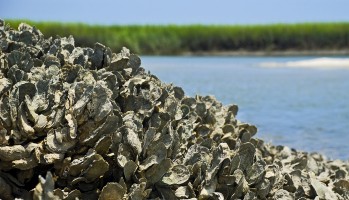UNC startup has developed a substrate for oyster seeding and growth that promotes oyster propagation and shoreline protection
This oyster-growing startup out of Morehead City is one of five NC IDEA spring 2016 grant winners.

Sandbar Oyster Company is one of five startups to win a collective $250,000 in grant funding from the nonprofit Durham-based NC IDEA Foundation. Since 2006, the foundation has awarded nearly $4.5 million to 109 startups around the state. The five companies were narrowed from 11 finalists, 26 semifinalists and 173 total applications for the Spring 2016 cycle.Oysters have a rich history of being a powerful economic asset to coastal communities. However, within the past four decades, they’ve received an unfortunate blow.
Due to a variety of factors ranging from overharvesting to storm-induced damage of habitats, oyster populations have declined significantly and catches require more effort than they’re worth. A 2001 report indicates a 93 percent drop in oysters’ dockside value since 1980.
But a Morehead City-based oyster-growing startup, one of this spring’s NC IDEA winners, has invented a solution meant to build sturdier reefs and reverse the declines.
Founded by Niels Lindquist, a University of North Carolina at Chapel Hill professor and marine scientist and David “Clammerhead” Cessna, a commercial shellfish harvester, Sandbar Oyster Company develops biodegradable surfaces on which oysters can survive and grow.
The goal is to bring oysters back into the coastal marketplace by getting commercial fisheries to adopt the company’s process.
Lindquist explains how it works: Placed along intertidal sandbars, a substrate material draws passing larvae to attach to the material. Since the surrounding environment is safe for oysters, they’ll survive well and grow quickly on the material’s surface. Next, a part of the surface that’s designed to break apart quickly sheds a group of small oysters, which Lindquist says are “excellent seeds for aquaculture.” The remaining, longer-lasting portion of the surface is then moved from the sandbar to future reef sites that’ll protect shorelines from erosion.
Last year, this approach was validated through a large-scale demonstration funded by UNC’s Office of Technology Development. After successful results, UNC filed a patent application covering Sandbar Oyster Company’s surface material and reef-building methods. The company is now teaming up with UNC for an exclusive license to commercialize the material and methods as well.
The NC IDEA grant will be instrumental in the Sandbar Oyster Company’s shift into the commercial stage later this year, Lindquist says.
NC IDEA Foundation’s president and CEO Thom Ruhe, also a judge in this year’s round of funding, says people may scratch their heads at the invention but, backed by a strong intellectual property, it’s offering a significant improvement to existing technology and could easily earn multi-millions of dollars if it can become a standard in the industry.
For the future, Lindquist anticipates “great success in North Carolina waters and a rapid expansion to other oyster growing regions in the U.S. and abroad.”
By Shannon Cuthrell
June 2016
Originally published at Exit Event.
Save

